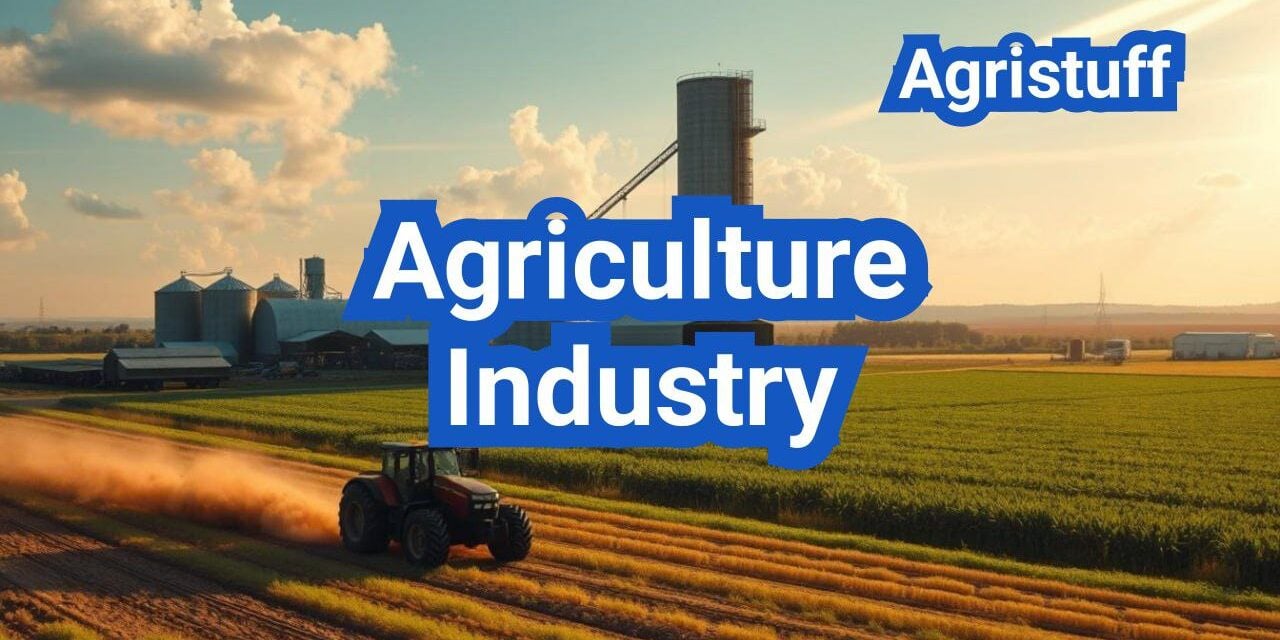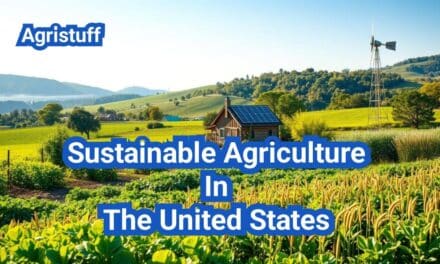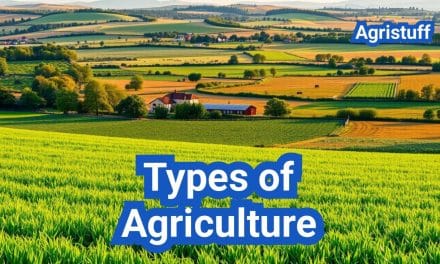The U.S. agriculture sector is a vital component of the national economy, involving a complex network of input suppliers, farmers, processors, and retailers. This intricate value chain contributes significantly to the country’s economic stability.
The agriculture industry in the U.S. encompasses various top segments, including crop production, livestock farming, and agricultural services. Emerging trends, such as precision farming and sustainable practices, are transforming the sector.
Key Takeaways
- The U.S. agriculture sector is a significant economic contributor.
- The industry’s value chain includes input suppliers, farmers, processors, and retailers.
- Top segments comprise crop production, livestock farming, and agricultural services.
- Emerging trends include precision farming and sustainable practices.
- The sector is expected to continue evolving with technological advancements.
Understanding the U.S. Agriculture Industry
To grasp the nuances of the U.S. agriculture industry, it’s essential to explore its foundational elements and historical context. The agriculture industry in the United States is a vital component of the national economy, encompassing a wide range of activities from crop production to livestock farming.
Definition and Scope of Agricultural Activities
Agricultural activities in the U.S. are diverse, including the production of crops such as corn, soybeans, and wheat, as well as livestock farming for meat, dairy, and poultry products. The agriculture industry also involves related sectors such as agricultural services, forestry, and fishing.
The scope of agricultural activities is not limited to farming alone; it extends to the entire value chain, including input supply, production, processing, and distribution. Understanding this scope is crucial for analyzing the industry’s overall performance and its impact on the national economy.
Historical Evolution of American Farming
The history of American farming is marked by significant technological advancements and changes in consumer demand. From the early days of manual labor to the current era of precision farming using GPS and drones, american farming has evolved substantially.
The historical evolution of farming practices has not only increased productivity but also transformed the way farming is conducted. For instance, the introduction of mechanized farming equipment in the early 20th century revolutionized crop production, while the advent of biotechnology has enabled the development of genetically modified crops.
| Period | Key Developments | Impact on Farming |
|---|---|---|
| Early 20th Century | Mechanization | Increased productivity and reduced labor |
| Late 20th Century | Biotechnology | Introduction of genetically modified crops |
| 21st Century | Precision Farming | Use of GPS, drones, and data analytics |
By understanding the historical context and the current state of agricultural activities, stakeholders can better navigate the complexities of the U.S. agriculture industry and make informed decisions.
Economic Impact of Agriculture on the U.S. Economy

The economic significance of the U.S. agriculture industry cannot be overstated. As a foundational sector, it contributes substantially to the national economy through various channels.
Agriculture’s Contribution to National GDP
The agriculture industry is a significant contributor to the U.S. Gross Domestic Product (GDP). According to recent data, the agricultural sector accounts for approximately 1% of the total GDP. However, its impact extends beyond this direct contribution, influencing related industries such as food processing and agricultural equipment manufacturing.
Agriculture’s GDP Contribution Breakdown
| Category | Contribution to GDP (%) | Value (Billions) |
|---|---|---|
| Agricultural Production | 0.7% | $144.4 |
| Food and Beverage Manufacturing | 1.2% | $234.1 |
| Agricultural Services and Forestry | 0.3% | $54.8 |
Employment Generation Across Related Sectors
Agriculture is a substantial source of employment in the United States, both directly and indirectly. The industry supports jobs not only in farming but also in related sectors such as agricultural services, food processing, and distribution.
Employment Figures in Agriculture and Related Sectors
- Agricultural Production: 2.6 million jobs
- Food Manufacturing: 1.5 million jobs
- Agricultural Services: 0.5 million jobs
Multiplier Effect on Rural Communities
The agriculture industry has a profound multiplier effect on rural communities, where farming is often the primary economic activity. The industry supports local economies through job creation, income generation, and the purchase of local goods and services.
Multiplier Effect Indicators
| Indicator | Value |
|---|---|
| Economic Multiplier | 2.5 |
| Jobs Supported per Farm Job | 2.64 |
Current Market Size of the Agriculture Industry in the USA
Understanding the market size of the U.S. agriculture industry provides insights into its overall performance. The agriculture industry is a vital component of the U.S. economy, with a significant impact on national GDP and employment.
Total Agricultural Production Value
The total agricultural production value in the United States is substantial, reflecting the industry’s importance. In recent years, the total value has reached into the hundreds of billions of dollars, driven by both crop and livestock production. The total agricultural production value was approximately $300 billion in recent years, highlighting the sector’s significant contribution to the national economy.
Regional Distribution of Farm Output
The regional distribution of farm output varies significantly across the United States. Different regions specialize in different types of agricultural production. For instance, the Midwest is known for its corn and soybean production, while California leads in the production of fruits and nuts. This regional specialization contributes to the overall efficiency and productivity of the U.S. agriculture industry.
Comparison with Other Economic Sectors
When comparing the agriculture industry to other economic sectors, its significance becomes even more apparent. Agriculture is one of the largest sectors in the U.S. economy, rivaling other major industries such as manufacturing and services. The industry’s output not only feeds the nation but also contributes to international trade, with the U.S. being a major exporter of agricultural products.
In conclusion, the current market size of the U.S. agriculture industry is a testament to its strength and importance. With a total agricultural production value of hundreds of billions of dollars and a diverse regional distribution of farm output, the industry plays a crucial role in the national economy.
Navigating the Agricultural Value Chain
The U.S. agricultural industry operates through a multifaceted value chain that involves various stakeholders, from input suppliers to retailers. Understanding this value chain is crucial for industry stakeholders to make informed decisions and optimize their operations.
Input Suppliers and Farm Input Costs
The agricultural value chain begins with input suppliers who provide essential goods and services to farmers. These inputs include seeds, fertilizers, pesticides, and equipment. The cost of these inputs significantly affects farmers’ operational expenses and profitability. For instance, the prices of fertilizers and pesticides can fluctuate based on global commodity markets, impacting farm input costs.
Farmers are increasingly looking for ways to manage these costs effectively, such as through precision agriculture techniques that optimize input usage. Input suppliers are also innovating by offering more efficient and sustainable products.
Production and Farming Operations
The next stage in the agricultural value chain is production, where farmers cultivate crops and raise livestock. This stage is critical as it determines the quality and quantity of agricultural products. Farming operations involve a range of activities, including planting, irrigation, pest management, and harvesting.
Advancements in technology, such as precision farming and automation, are transforming farming operations by improving efficiency and reducing labor costs. These technologies enable farmers to make data-driven decisions, enhancing productivity and sustainability.
Processing, Distribution, and Retail
After production, agricultural products move through the value chain to processing, distribution, and retail. Processing involves transforming raw agricultural products into consumable goods, such as through milling, canning, or packaging.
Distribution networks play a vital role in ensuring that products reach consumers efficiently. This involves logistics and transportation companies that move products from processing facilities to retail outlets. Retailers then sell these products to consumers, completing the value chain.
The rise of e-commerce and direct-to-consumer sales is changing the dynamics of the agricultural value chain, providing new opportunities for farmers and processors to connect directly with consumers.
Major Segments of the U.S. Agriculture Industry
The U.S. agriculture industry is a complex and multifaceted sector that plays a crucial role in the country’s economy and food security. It encompasses various segments, each contributing significantly to the overall agricultural output.
Crop Production Systems
Crop production is a vital component of the U.S. agriculture industry, with the country being one of the world’s largest producers of crops such as corn, soybeans, and wheat. The use of advanced farming techniques and technology has significantly increased crop yields over the years.
Crop Production Statistics
| Crop | Production Volume (2022) | Major Producing States |
|---|---|---|
| Corn | 13.6 billion bushels | Iowa, Illinois, Nebraska |
| Soybeans | 4.4 billion bushels | Illinois, Iowa, Indiana |
| Wheat | 1.8 billion bushels | Kansas, North Dakota, Montana |
Livestock and Animal Products
Livestock production is another significant segment of the U.S. agriculture industry, with the country producing a substantial amount of meat, dairy, and poultry products. The industry has seen advancements in breeding and feeding practices, leading to improved productivity.
The Importance of Livestock
- Provides a significant source of protein for human consumption
- Contributes to the rural economy through employment and income generation
- Utilizes land that may not be suitable for crop production
Food Manufacturing and Processing
Food manufacturing and processing is a critical link between the farm and the consumer, involving the transformation of raw agricultural products into consumable goods. This segment has seen significant innovation, with companies investing in new technologies to improve efficiency and product quality.
Trends in Food Manufacturing
- Increased demand for organic and non-GMO products
- Greater emphasis on sustainability and environmental responsibility
- Advancements in food processing technologies
How to Analyze U.S. Farm Income Forecasts
Understanding the nuances of U.S. farm income forecasts can help farmers and agribusinesses navigate market fluctuations. To make informed decisions, it’s crucial to analyze these forecasts comprehensively.
Understanding USDA ERS Data
The USDA’s Economic Research Service (ERS) provides valuable data on farm income, which is essential for analyzing farm income forecasts. The ERS data includes gross farm income, production expenses, and net farm income, among other metrics.
Key components of USDA ERS data:
- Gross farm income
- Production expenses
- Net farm income
- Government payments
Interpreting Farm Income Trends
Interpreting farm income trends is vital for understanding the overall health of the agricultural sector. By analyzing these trends, farmers and agribusinesses can identify areas of opportunity and potential risks.
Factors influencing farm income trends:
- Commodity prices
- Weather conditions
- Government policies
- Global market demand
Using Forecasts for Business Planning
Farm income forecasts can be a powerful tool for business planning. By understanding the forecasted trends and changes in farm income, agricultural businesses can make informed decisions about investments, production levels, and marketing strategies.
Steps to use forecasts for business planning:
- Review and analyze the latest farm income forecasts
- Assess the potential impact on your business
- Adjust your business plan accordingly
- Monitor and update your plan as new forecasts become available
Leading Agriculture Industry Companies in America
The agriculture sector in the United States is characterized by a diverse range of companies, from multinational corporations to local cooperatives. These industry leaders are driving innovation, efficiency, and sustainability across the agricultural value chain.
Top Agribusiness Corporations
Agribusiness corporations play a significant role in the U.S. agriculture industry, providing essential inputs, equipment, and services to farmers. Companies like Cargill, Archer Daniels Midland (ADM), and Bunge are among the largest players, involved in various aspects of agricultural production and trade.
These corporations have a substantial impact on the global agricultural market, influencing commodity prices and trade flows. As stated by the CEO of Cargill, “Agriculture is at the heart of everything we do, and we’re committed to nourishing the world in a sustainable way.”
“The future of agriculture depends on our ability to innovate and adapt to changing conditions.”
— David MacLennan, CEO, Cargill
Innovative AgTech Startups
Innovative AgTech startups are revolutionizing the agriculture industry with cutting-edge technologies, including precision farming, drones, and AI-powered analytics. Companies like John Deere’s FarmSight and Granular are at the forefront of this technological transformation, helping farmers optimize crop yields, reduce waste, and improve resource allocation.
These startups are not only improving agricultural productivity but also enhancing sustainability. For instance, precision agriculture technologies enable farmers to apply water, fertilizers, and pesticides more efficiently, reducing environmental impact.
Regional Agricultural Cooperatives
Regional agricultural cooperatives are member-owned businesses that serve the needs of local farmers and rural communities. These cooperatives provide a range of services, including marketing, processing, and distribution of agricultural products, as well as supply of inputs like seeds, fertilizers, and equipment.
Cooperatives like Land O’Lakes and Growmark play a vital role in supporting local economies and promoting agricultural development at the grassroots level. They also offer a platform for farmers to collaborate, share knowledge, and negotiate better prices for their products.
By working together, these different types of agriculture industry companies are shaping the future of American agriculture, driving growth, innovation, and sustainability.
Agricultural Employment Landscape and Career Opportunities

The agricultural employment landscape in the United States is characterized by a wide range of career opportunities, reflecting the industry’s complexity and diversity. As the backbone of the country’s economy, agriculture provides employment across various sectors, from traditional farming to advanced agricultural technology.
In-Demand Agriculture Industry Jobs
The agriculture industry is evolving, driven by technological advancements and changing consumer demands. As a result, certain jobs are in high demand:
- Agricultural Engineers
- Precision Agriculture Specialists
- Farm Managers
- Agricultural Scientists
- Data Analysts for Farm Management
These roles are crucial for improving efficiency, productivity, and sustainability in agricultural practices.
Skills and Qualifications for Modern Farming
Modern farming requires a diverse set of skills and qualifications. Key among these are:
- Technical skills in farm machinery operation and maintenance
- Knowledge of precision agriculture technologies
- Understanding of sustainable farming practices
- Data analysis skills for informed decision-making
- Business management skills for farm operations
Additionally, soft skills such as problem-solving, communication, and adaptability are highly valued in the agricultural workforce.
Addressing Agricultural Labor Market Challenges
The agricultural labor market faces several challenges, including labor shortages, immigration policy impacts, and the need for skilled workers. To address these challenges, the industry is adopting innovative solutions:
| Challenge | Solution |
|---|---|
| Labor Shortages | Mechanization and automation |
| Immigration Policy Impacts | Advocacy for fair labor policies |
| Need for Skilled Workers | Training and education programs |
By embracing technology and investing in workforce development, the agricultural sector can mitigate these challenges and continue to thrive.
U.S. Agricultural Exports and Global Trade Position

U.S. agricultural exports are a crucial component of the country’s trade balance, contributing to both domestic and international food security. The significance of these exports is multifaceted, impacting various aspects of the agricultural industry and the broader economy.
Major Export Products and Destinations
The U.S. exports a diverse range of agricultural products, including grains, soybeans, fruits, and livestock products. Grains such as corn and wheat are among the top export commodities, with soybeans being another significant export product. The primary destinations for these exports include countries in Asia, such as China and Japan, as well as nations in Latin America and Europe.
Top U.S. Agricultural Export Products:
- Corn
- Soybeans
- Wheat
- Fruits (including almonds and pistachios)
- Livestock products
| Export Product | Primary Destinations | Export Value (2022) |
|---|---|---|
| Corn | China, Mexico, Japan | $4.5 billion |
| Soybeans | China, Indonesia, India | $23.4 billion |
| Wheat | Mexico, Japan, Philippines | $6.2 billion |
California’s Agricultural Export Success Story
California is a leading state in agricultural exports, with a diverse range of products that include nuts, fruits, and dairy products. The state’s agricultural export success can be attributed to its favorable climate, advanced farming practices, and efficient logistics. In 2022, California’s agricultural exports totaled over $22 billion, with almonds and dairy products being among the top export commodities.
How to Access International Markets
For U.S. agricultural businesses looking to expand into international markets, several strategies can be employed. These include conducting market research to identify potential destinations, complying with international regulations and standards, and developing effective marketing campaigns. Additionally, leveraging trade agreements and participating in export promotion programs can facilitate entry into new markets.
Key Steps to Accessing International Markets:
- Conduct thorough market research
- Comply with international regulations
- Develop targeted marketing strategies
- Utilize trade agreements and export promotion programs
Implementing Precision Agriculture Technologies
The integration of precision agriculture technologies is redefining the future of American farming. By leveraging advanced tools and techniques, farmers can significantly enhance efficiency, productivity, and sustainability.
GPS-Guided Equipment and Automation
GPS-guided equipment has revolutionized farming by enabling precise planting, spraying, and harvesting. This technology reduces waste, improves crop yields, and minimizes environmental impact.
Key benefits of GPS-guided equipment include:
- Improved accuracy in farming operations
- Reduced input costs through minimized overlap
- Enhanced crop yields due to precise application of inputs
Data Analytics and Farm Management Software
Data analytics and farm management software play a crucial role in precision agriculture. These tools help farmers make informed decisions by analyzing data from various sources, including weather stations, soil sensors, and yield monitors.
| Feature | Benefit |
|---|---|
| Weather forecasting | Optimized irrigation and crop protection |
| Soil moisture monitoring | Precision irrigation management |
| Yield analysis | Data-driven decisions for future crops |
ROI Assessment for Technology Adoption
Assessing the return on investment (ROI) is critical for farmers considering the adoption of precision agriculture technologies. By evaluating the costs and benefits, farmers can make informed decisions about technology investments.
Factors to consider in ROI assessment include:
- Initial investment costs
- Ongoing maintenance and operational costs
- Potential increases in productivity and efficiency
By carefully evaluating these factors, farmers can determine the potential ROI of precision agriculture technologies and make informed decisions about their adoption.
Agricultural Equipment and Machinery Advancements

As technology advances, agricultural equipment is becoming more sophisticated, enabling farmers to optimize their operations and improve yields. The agriculture industry is witnessing significant advancements in equipment and machinery, driven by the need for increased efficiency, productivity, and sustainability.
High-Tech Agriculture Equipment Trends
The latest trends in agricultural equipment are characterized by the integration of advanced technologies such as GPS, IoT sensors, and data analytics. These innovations enable farmers to make data-driven decisions, reduce waste, and enhance crop yields.
Key Trends:
- Precision farming equipment with GPS guidance
- Automated farming machinery with IoT sensors
- Data analytics software for farm management
Autonomous Farming Machinery
Autonomous farming machinery is revolutionizing the agricultural landscape by enhancing efficiency, reducing labor costs, and improving crop yields. Autonomous tractors and drones are being increasingly adopted by farmers to optimize their farming operations.
Benefits of Autonomous Machinery:
- Increased precision and reduced human error
- Enhanced operational efficiency and productivity
- Reduced labor costs and improved safety
Equipment Selection and Investment Strategies
Selecting the right agricultural equipment and machinery is crucial for farmers to optimize their operations and improve profitability. Factors such as farm size, crop type, and budget must be considered when making investment decisions.
| Equipment Type | Key Features | Investment Considerations |
|---|---|---|
| Tractors | GPS guidance, automation | Initial cost, maintenance, fuel efficiency |
| Combine Harvesters | Advanced threshing mechanisms, grain monitoring systems | Capacity, efficiency, operator training |
| Drones | Multispectral imaging, crop monitoring | Cost, data analysis software, regulatory compliance |
By understanding the latest advancements in agricultural equipment and machinery, farmers can make informed decisions to enhance their operations, improve productivity, and increase profitability.
Sustainable Practices in Modern Farming

Modern farming in the U.S. is shifting towards more sustainable methods to reduce its environmental footprint. This shift is driven by the need to address climate change, conserve natural resources, and ensure the long-term viability of agricultural practices.
Conservation Agriculture Methods
Conservation agriculture involves minimal soil disturbance, permanent soil cover, and crop rotations. These practices help reduce soil erosion, improve soil health, and increase biodiversity. Conservation tillage, for instance, reduces the need for intensive tilling, preserving soil organic matter and reducing fuel consumption.
The benefits of conservation agriculture are multifaceted. By reducing soil disturbance, farmers can improve water retention, decrease soil compaction, and promote soil biota. This approach also helps in sequestering carbon in the soil, contributing to climate change mitigation.
Optimizing Water Use in Agriculture
Water conservation is critical in agriculture, given the sector’s significant water usage. Techniques such as drip irrigation and precision sprinklers help deliver water directly to the roots of plants, reducing evaporation and runoff. These methods not only conserve water but also improve crop yields.
Another strategy is the use of drought-tolerant crop varieties. These crops are bred to thrive with minimal water, reducing the strain on water resources during dry periods. Additionally, mulching and cover cropping help retain soil moisture and reduce the need for irrigation.
| Water Conservation Technique | Description | Benefits |
|---|---|---|
| Drip Irrigation | Delivers water directly to plant roots | Reduces evaporation and runoff |
| Drought-Tolerant Crops | Crops bred to thrive with minimal water | Reduces strain on water resources |
| Mulching | Covers soil to retain moisture | Reduces need for irrigation |
Carbon Sequestration and Climate-Smart Farming
Climate-smart farming involves practices that help farmers adapt to climate change while mitigating its effects. Carbon sequestration is a key aspect, achieved through practices like agroforestry, cover cropping, and incorporating organic amendments into the soil.
Agroforestry, for example, involves integrating trees into farming systems. Trees absorb carbon dioxide, produce oxygen, and provide shade, improving biodiversity and reducing the carbon footprint of farming operations. Cover cropping and crop rotation also contribute to carbon sequestration by enhancing soil health and reducing the need for synthetic fertilizers.
By adopting these climate-smart practices, farmers can improve the resilience of their operations to climate change, enhance ecosystem services, and contribute to a more sustainable food system.
Navigating Regulatory Compliance in Agriculture

Navigating the regulatory landscape is essential for agricultural businesses to operate legally and sustainably. The U.S. agriculture industry is subject to a myriad of regulations that impact various aspects of farming and agribusiness operations.
FSMA Compliance Requirements
The Food Safety Modernization Act (FSMA) represents a significant shift in the way the FDA regulates food safety, focusing on prevention rather than response. Compliance with FSMA requires agricultural producers to implement practices that minimize the risk of contamination.
Key FSMA Requirements:
- Implementing preventive controls
- Conducting regular monitoring and verification
- Maintaining detailed records
Environmental Regulations
Agricultural operations are also subject to various environmental regulations aimed at protecting natural resources. Compliance with these regulations is crucial for sustainable farming practices.
| Regulation | Description | Impact on Agriculture |
|---|---|---|
| Clean Water Act | Regulates discharges into water bodies | Requires farms to manage runoff and waste |
| Endangered Species Act | Protects threatened and endangered species | Impacts land use and water management |
Certification Programs and Standards
Certification programs and standards play a crucial role in ensuring compliance with regulatory requirements and demonstrating commitment to quality and sustainability.
Examples include USDA Organic certification and various industry-specific standards. Compliance with these programs can enhance market access and consumer trust.
Risk Management Strategies for Agricultural Businesses
Agricultural businesses in the U.S. face a multitude of risks that can significantly impact their operations and profitability. These risks include weather-related events, market fluctuations, and regulatory changes, among others. Effective risk management is crucial for these businesses to mitigate potential losses and ensure long-term sustainability.
Utilizing Crop Insurance Programs
Crop insurance is a vital risk management tool for agricultural businesses. It provides financial protection against crop losses due to natural disasters, disease, or other unforeseen events. The U.S. Department of Agriculture’s (USDA) Risk Management Agency (RMA) offers various crop insurance programs tailored to different crops and regions.
“Crop insurance is essential for farmers to manage risk and ensure the stability of their operations,” said a USDA spokesperson. “It allows them to invest in their farms with confidence, knowing they have a safety net in case of unforeseen events.”
Diversification and Hedging Techniques
Diversification is another key risk management strategy. By diversifying their operations, agricultural businesses can reduce their dependence on a single crop or revenue stream. This can include planting multiple crops, integrating livestock into their operations, or exploring alternative revenue streams such as agritourism.
Hedging is a financial strategy used to mitigate price risks. Agricultural businesses can use futures contracts, options, and other financial instruments to lock in prices for their products, protecting themselves against market fluctuations.
- Diversify crop production to reduce reliance on a single crop.
- Use futures contracts and options to hedge against price fluctuations.
- Explore alternative revenue streams, such as agritourism.
Climate Risk Adaptation Approaches
Climate change poses significant risks to agricultural businesses, including increased frequency of extreme weather events, changing precipitation patterns, and rising temperatures. To adapt to these changes, agricultural businesses can adopt various strategies, such as:
- Implementing conservation agriculture practices to improve soil health and resilience.
- Using climate-resilient crop and animal varieties.
- Adopting precision agriculture technologies to optimize water use and reduce waste.
As John Smith, a leading agricultural expert, notes, “Climate risk adaptation is crucial for the long-term sustainability of agricultural businesses. By adopting proactive strategies, farmers can reduce their vulnerability to climate-related risks and improve their resilience.”
By implementing these risk management strategies, agricultural businesses can better navigate the complexities of the industry and ensure their long-term sustainability.
How to Optimize Agricultural Supply Chains
The agricultural supply chain is a complex network that requires optimization to ensure efficiency and resilience. It involves various stakeholders, including farmers, processors, distributors, and retailers, all working together to bring products from the farm to the consumer.
Supply Chain Resilience Building
Building resilience in agricultural supply chains is crucial for withstanding disruptions such as natural disasters, economic fluctuations, and global health crises. Supply chain resilience involves developing strategies to mitigate risks and ensure continuity. This can be achieved through:
- Diversifying suppliers to reduce dependence on a single entity
- Implementing robust risk management practices
- Investing in supply chain visibility technologies
Logistics and Transportation Efficiency
Efficient logistics and transportation are critical components of an optimized agricultural supply chain. Improving these aspects can lead to reduced costs, faster delivery times, and increased customer satisfaction. Strategies for enhancing logistics and transportation efficiency include:
- Utilizing advanced routing and scheduling software
- Investing in modern transportation infrastructure
- Implementing real-time tracking and monitoring systems
Technology-Enabled Supply Chain Management
Technology plays a vital role in optimizing agricultural supply chains. Technology-enabled supply chain management involves leveraging digital tools and platforms to enhance visibility, efficiency, and decision-making. Some key technologies include:
- Blockchain for traceability and transparency
- Data analytics for demand forecasting and inventory management
- Internet of Things (IoT) devices for real-time monitoring
By adopting these technologies, agricultural businesses can improve their supply chain operations and stay competitive in a rapidly changing market.
Future Trends Reshaping the U.S. Agriculture Industry
The U.S. agriculture industry is on the cusp of a revolution, driven by emerging trends and technological advancements. Future trends are expected to significantly impact the industry, from the adoption of new agricultural technologies to changing consumer demands.
One of the key future trends is the increasing use of precision agriculture, which involves the use of advanced technologies such as GPS-guided equipment and data analytics to optimize crop yields and reduce waste. Agricultural technology is also being used to improve crop monitoring, predictive analytics, and automation.
The U.S. agriculture industry is also expected to be shaped by emerging trends such as vertical farming, organic farming, and regenerative agriculture. These trends are driven by changing consumer demands for sustainable and environmentally friendly products.
As the industry continues to evolve, it is essential for farmers, agricultural businesses, and policymakers to stay informed about the latest developments and trends. By understanding the future trends reshaping the U.S. agriculture industry, stakeholders can make informed decisions and capitalize on new opportunities.
FAQ
What is the significance of the agriculture industry in the U.S. economy?
The agriculture industry is a vital component of the U.S. economy, contributing to national GDP, generating employment across related sectors, and having a multiplier effect on rural communities.
What are the major segments of the U.S. agriculture industry?
The major segments of the U.S. agriculture industry include crop production systems, livestock and animal products, and food manufacturing and food processing.
How can farmers analyze U.S. farm income forecasts?
Farmers can analyze U.S. farm income forecasts by understanding USDA ERS data, interpreting farm income trends, and using forecasts for business planning.
What are the benefits of implementing precision agriculture technologies?
The benefits of implementing precision agriculture technologies include improved crop yields, reduced input costs, and enhanced decision-making through data analytics.
What are the key trends reshaping the U.S. agriculture industry?
The key trends reshaping the U.S. agriculture industry include the adoption of precision agriculture technologies, sustainable practices, and the increasing importance of agricultural exports.
How can agricultural businesses manage risk?
Agricultural businesses can manage risk by utilizing crop insurance programs, diversification and hedging techniques, and climate risk adaptation approaches.
What are the regulatory compliance requirements in agriculture?
The regulatory compliance requirements in agriculture include FSMA compliance requirements, environmental regulations, and certification programs and standards.
How can agricultural supply chains be optimized?
Agricultural supply chains can be optimized by building supply chain resilience, improving logistics and transportation efficiency, and leveraging technology-enabled supply chain management.
What is the role of agricultural cooperatives in the industry?
Agricultural cooperatives play a crucial role in the industry by providing support to farmers, improving market access, and promoting sustainable practices.
What are the emerging trends in agricultural equipment and machinery?
The emerging trends in agricultural equipment and machinery include the adoption of high-tech agriculture equipment, autonomous farming machinery, and equipment selection and investment strategies.
How does agriculture contribute to the U.S. economy?
Agriculture contributes to the U.S. economy by generating employment, producing food and fiber, and stimulating economic growth in rural areas.
What is the importance of sustainable practices in modern farming?
Sustainable practices are essential in modern farming as they promote environmental stewardship, improve crop yields, and reduce the environmental impact of farming operations.
Conclusion of: The Agriculture Industry In The U.S.
Overview: why the agriculture industry still anchors the U.S. economy
The agriculture industry in the United States is bigger than fields and barns—it spans inputs, farms, food manufacturing, logistics, retail, and food service, together supporting millions of jobs and a meaningful share of GDP. From the seeds we plant to the restaurants where families eat, the agriculture industry underpins food security, rural livelihoods, and global trade, while steadily adopting technology to stay productive and competitive. USDA ERS: Ag & Food Sectors and the Economy
How value is created across the agriculture industry’s supply chain
The agriculture industry turns inputs into value through a linked chain: seed, fertilizer, and equipment providers; on-farm production; processing and packaging; wholesale distribution; and food retail/food service. The “middle mile”—storage, cold chain, and transportation—often determines efficiency and profitability. When these links are coordinated with data standards and modern infrastructure, the agriculture industry reduces waste, shortens lead times, and keeps food affordable. USDA AMS: Agricultural Marketing & Supply Chain Programs
Inputs and costs: what shapes margins in the agriculture industry
In the agriculture industry, input prices set the cost floor. Feed, fertilizer, seed, fuel, labor, interest, and land rent drive producers’ decisions on acreage, herd size, and technology upgrades. Shifts in any one category—such as fertilizer or interest rates—can cascade through the agriculture industry, affecting cash flow, borrowing, and risk appetite for new investments. USDA ERS: Farm Sector Income Forecast
Production backbone: major crops and livestock in the agriculture industry
At its core, the agriculture industry is powered by on-farm production. Corn, soybeans, wheat, hay, cotton, cattle, dairy, hogs, broilers, and eggs dominate cash receipts, while specialty crops—from almonds to leafy greens—add diversity and regional strength. These outputs supply processors and retailers, and they also anchor export earnings that sustain the wider agriculture industry. USDA ERS: Farm Income & Wealth Statistics
Food manufacturing: where the agriculture industry adds most value
After harvest or slaughter, the agriculture industry creates more value in food manufacturing—everything from grain milling and dairy processing to meat packing and bakeries. This stage (NAICS 311) improves safety, shelf life, and convenience, and it is critical for trade competitiveness. Strong plants, skilled labor, and quality management systems turn bulk commodities into high-value foods that power the agriculture industry’s margins. BLS: Food Manufacturing (NAICS 311)
Distribution, retail, and food service: demand engines for the agriculture industry
On the demand side, the agriculture industry depends on wholesalers, grocers, restaurants, and institutional food service to convert production into consumer meals. Household food spending patterns influence what gets grown and processed, while logistics and cold chain performance determine freshness and shrink. Tight alignment between upstream and downstream players keeps the agriculture industry resilient. USDA ERS: Food Prices & Spending
Industry structure: small family farms and the scale dynamics of the agriculture industry
The agriculture industry features nearly two million farms, the vast majority family-owned. Many are small by sales, yet a large share of production comes from bigger operations that achieve economies of scale and adopt technology faster. This structural mix shapes pricing power, input purchasing, and contracting, and it explains why policy and programs must fit diverse business models across the agriculture industry. USDA NASS: Census of Agriculture
Trade: why exports and market access matter to the agriculture industry
Exports help the agriculture industry balance supply and sustain prices. Canada, Mexico, and key Asian partners account for a large share of U.S. farm product demand. When exchange rates, sanitary standards, and shipping costs move, they affect on-farm incomes, processing throughput, and investment appetite throughout the agriculture industry. USDA ERS: U.S. Agricultural Trade at a Glance
Labor and skills: people at the heart of the agriculture industry
Despite automation, the agriculture industry still relies on skilled people for crop care, animal husbandry, food safety, and plant operations. Labor availability and wage trends remain pivotal constraints, especially at harvest and in processing facilities. Investing in training, safety, and career pathways keeps the agriculture industry productive and reduces costly turnover. USDA ERS: Farm Labor
Technology: precision tools transforming the agriculture industry
Auto-steer, GPS guidance, variable-rate application, soil and canopy sensors, drones, and farm management software are reshaping the agriculture industry. Precision tools reduce input waste, enhance yields, and generate data that informs better decisions from planting through marketing. Adoption tends to rise with farm size, but benefits spread across the entire agriculture industry as tools become more affordable. USDA ERS: Precision Agriculture
Environmental footprint: emissions and stewardship in the agriculture industry
Balancing output with stewardship is central to the agriculture industry. Agriculture contributes to national greenhouse gas emissions—primarily nitrous oxide from soils and methane from livestock—while land use and forestry remain a net sink. Nutrient management, feed additives, manure systems, and methane capture are all evolving to reduce the footprint without sacrificing the agriculture industry’s productivity. EPA: Sources of GHG Emissions – Agriculture
Water and land: resource intensity across the agriculture industry
Irrigation, livestock watering, and processing make the agriculture industry a major water user, especially in western and plains states. Modern irrigation scheduling, drip systems, and soil-moisture monitoring help conserve water while protecting yields. Long-term resilience for the agriculture industry will hinge on efficient water use and drought-ready infrastructure. USGS: Water Use in the United States
Food safety rules that knit together the agriculture industry
From farm to fork, the agriculture industry depends on strong food safety systems. The FDA’s Food Safety Modernization Act (FSMA) emphasizes prevention—produce safety, hazard analysis, and risk-based controls—while USDA’s FSIS oversees meat, poultry, and egg product inspection. Compliance investments protect consumers and preserve market access for the agriculture industry. FDA: FSMA Overview
Meat, poultry, and eggs: inspection safeguards for the agriculture industry
Within the agriculture industry, continuous federal inspection for meat, poultry, and certain egg products underpins domestic confidence and export eligibility. Science-based standards, verification, and recall procedures keep plants accountable and help the agriculture industry rapidly address issues when they arise. USDA FSIS: Food Safety & Inspection Service
Finance and risk management: stabilizers for the agriculture industry
Weather and price swings make risk tools vital across the agriculture industry. Crop insurance—administered by USDA’s Risk Management Agency—covers yield and revenue risks across major and many specialty crops. Effective risk transfer unlocks working capital and credit for equipment upgrades that strengthen the agriculture industry’s resilience. USDA RMA: Risk Management Agency
Logistics resilience: strengthening the middle of the agriculture industry
Pandemic-era disruptions exposed gaps in the agriculture industry middle mile: regional processing capacity, cold storage, and aggregation hubs. Federal and state grants aimed at resilient food systems are expanding capacity and market access, especially for small and midsize producers, which strengthens the entire agriculture industry. USDA AMS: Resilient Food Systems Infrastructure
Outlook: what 2025 means for the agriculture industry
Looking ahead, the agriculture industry will navigate shifting input costs, labor availability, climate risks, and evolving consumer demand. Productivity gains, improved risk tools, and targeted infrastructure funding can offset volatility. Trade performance will continue to influence cash receipts, margins, and investment across the agriculture industry. USDA ERS: Farm Sector Outlook
Regional lenses: state-by-state signals inside the agriculture industry
Because production is regional, understanding local trends helps the agriculture industry tailor strategy. Dairy in Wisconsin, specialty crops in California and Florida, cotton in Texas, and corn/soy in the Midwest each face distinct policies, water realities, and labor markets. State fact sheets and dashboards help benchmark performance within the agriculture industry. USDA ERS: State Fact Sheets
Productivity: the long-run engine of the agriculture industry
Since mid-century, total factor productivity growth enabled the agriculture industry to produce more with roughly flat inputs—thanks to genetics, equipment, crop protection, and management innovations. Keeping this engine running requires sustained R&D, diffusion of precision tools, and workforce development that help the agriculture industry meet demand sustainably. USDA ERS: Agricultural Productivity
Financing equipment and infrastructure across the agriculture industry
Capital is the lifeblood of the agriculture industry—from planters and combines to refrigeration and food-grade warehousing. Favorable credit terms, collateral values, and risk coverage determine whether farms and processors modernize. Strategic capex improves throughput, reduces unit costs, and boosts the competitiveness of the agriculture industry at home and abroad. USDA ERS: Farm Business Income & Finance
Conservation programs: aligning profit and stewardship in the agriculture industry
NRCS programs help the agriculture industry adopt practices that protect soil, water, and habitat while maintaining profitability. Assistance through EQIP and CSP supports nutrient management, cover crops, grazing systems, and irrigation efficiency—investments that build resilience and long-term value for the agriculture industry. USDA NRCS: EQIP
Data and benchmarking: decision tools for the agriculture industry
Public datasets and dashboards give the agriculture industry transparency on prices, costs, yields, trade, and risks. Producers, lenders, and processors use these benchmarks to plan, hedge, and invest. High-quality statistics are a competitive advantage, enabling the agriculture industry to move faster with evidence-based decisions. USDA NASS: Quick Stats
Consumer trends reshaping the agriculture industry
Health, convenience, and sustainability expectations flow upstream to the agriculture industry. Demand for high-protein dairy, minimally processed foods, and transparent labeling influences crop rotations, animal feed, and processing lines. Companies that read these signals and innovate early often win share across the agriculture industry. FDA: Food Labeling & Nutrition
Digital traceability and the next frontier for the agriculture industry
Traceability—from field blocks to retail lots—helps the agriculture industry manage recalls, verify claims, and reduce shrink. Interoperable data standards, IoT sensors, and real-time monitoring shorten response times and protect brand trust. As costs fall, digital traceability becomes a baseline capability for the agriculture industry. FDA: FSMA Traceability Rule
Insurance, hedging, and price discovery across the agriculture industry
The agriculture industry uses crop insurance, futures, and options to stabilize revenue and manage risk. Price discovery through transparent markets informs planting, feeding, and processing decisions. These tools provide guardrails that keep the agriculture industry investing through cycles. USDA RMA: Insurance Plans
Export logistics and market diversification for the agriculture industry
Ports, rail, and container availability can make or break margins in the agriculture industry. Diversified customers across North America and Asia reduce concentration risk, while quality and sanitary standards secure premium access. Efficient logistics amplify the competitive edge of the agriculture industry. USDA ERS: U.S. Agricultural Trade
Final thought
The agriculture industry is simultaneously a modern logistics network and a land-based biological system. The leaders will unify precision technology, resilient middle-mile infrastructure, skilled people, strong risk tools, and conservation to deliver affordable, safe food—while keeping the agriculture industry profitable and sustainable for decades to come. USDA ERS: Charting the Essentials
Sources & References
- USDA ERS — Ag & Food Sectors and the Economy
- USDA AMS — Agricultural Marketing Service
- USDA ERS — Farm Sector Income Forecast
- USDA ERS — Farm Income & Wealth Statistics
- BLS — Food Manufacturing (NAICS 311)
- USDA ERS — Food Prices & Spending
- USDA NASS — Census of Agriculture
- USDA ERS — Agricultural Trade at a Glance
- USDA ERS — Farm Labor
- EPA — Sources of Greenhouse Gas Emissions: Agriculture
- USGS — Water Use in the United States
- USDA FSIS — Food Safety & Inspection Service
- USDA RMA — Risk Management Agency
- USDA AMS — Resilient Food Systems Infrastructure
- USDA ERS — State Fact Sheets
- USDA ERS — Agricultural Productivity in the U.S.
- USDA NASS — Quick Stats
- FDA — Food Labeling & Nutrition










